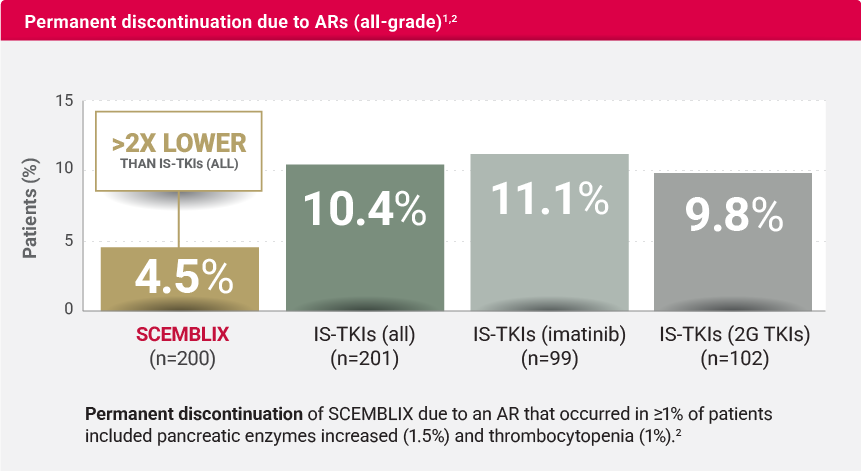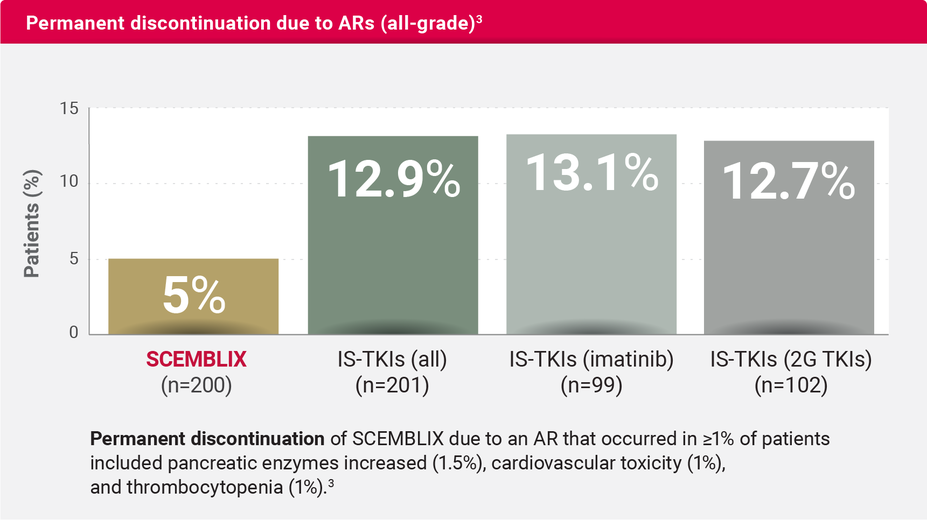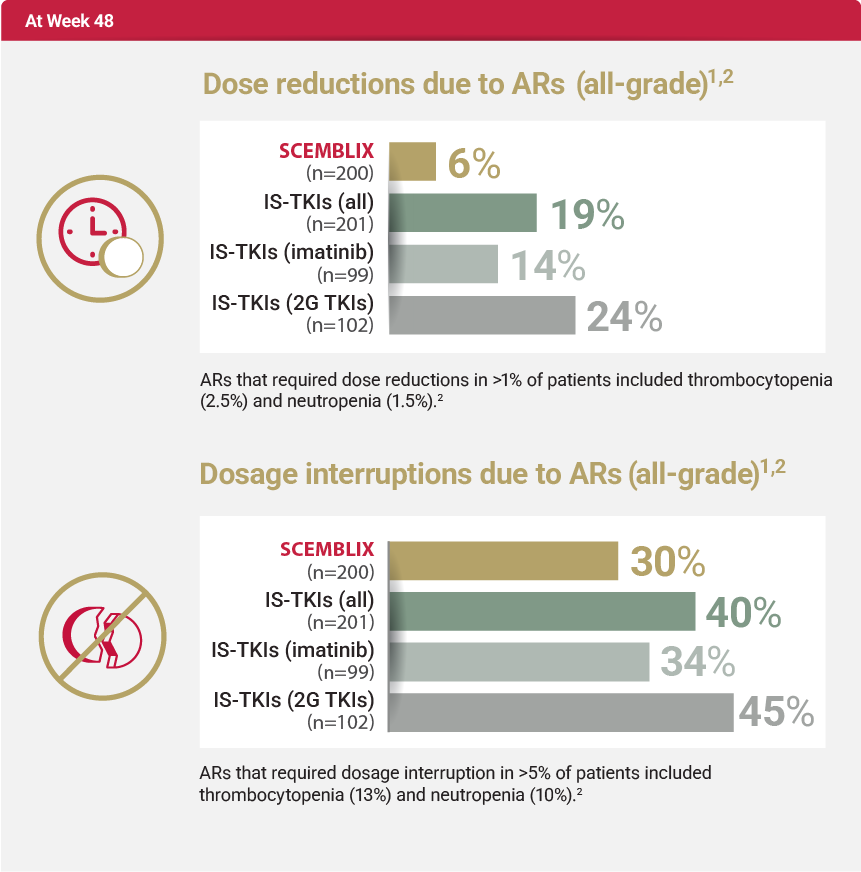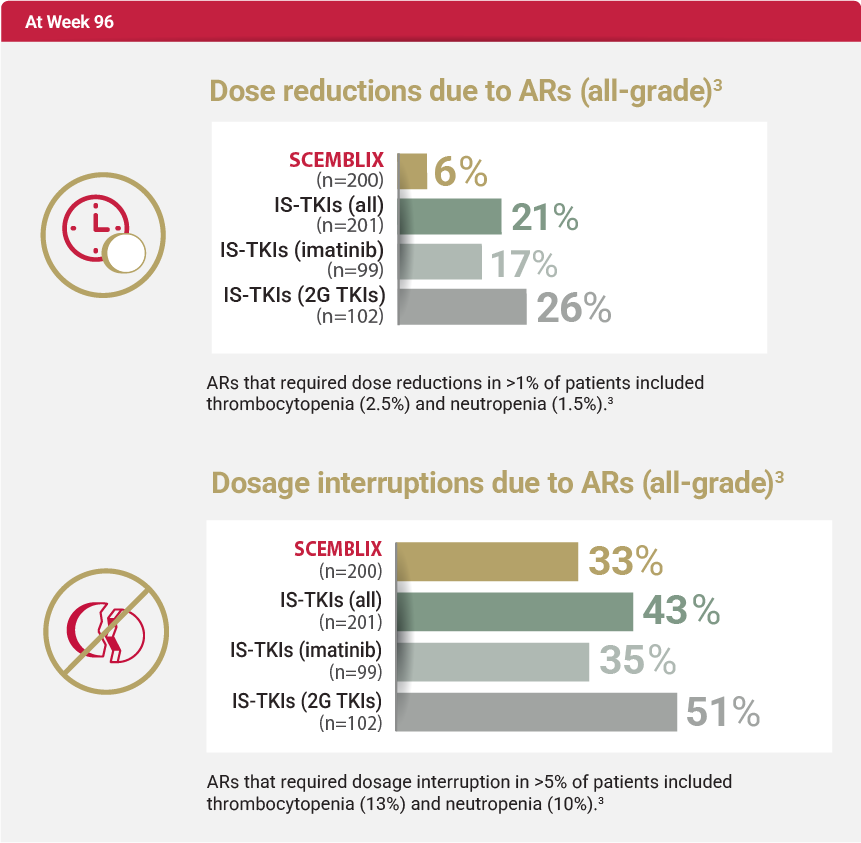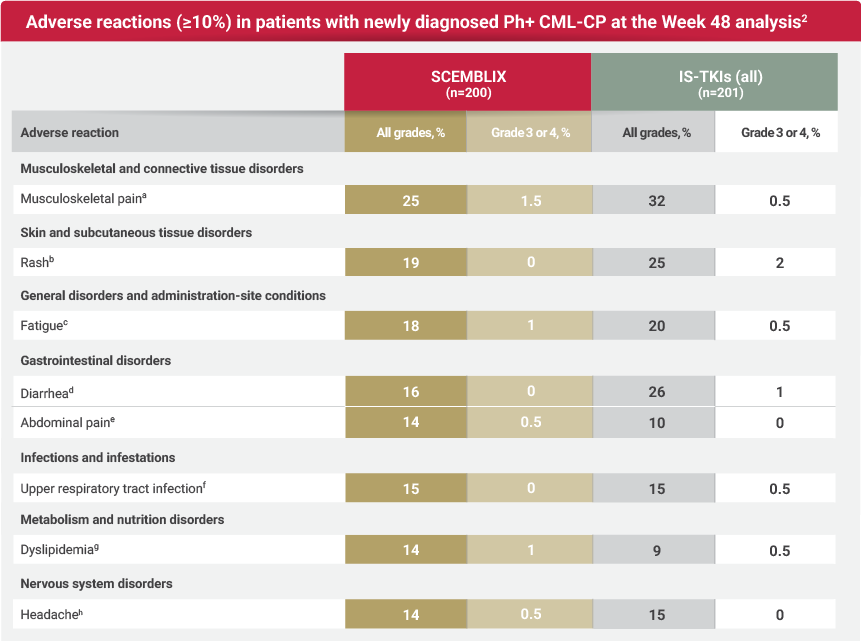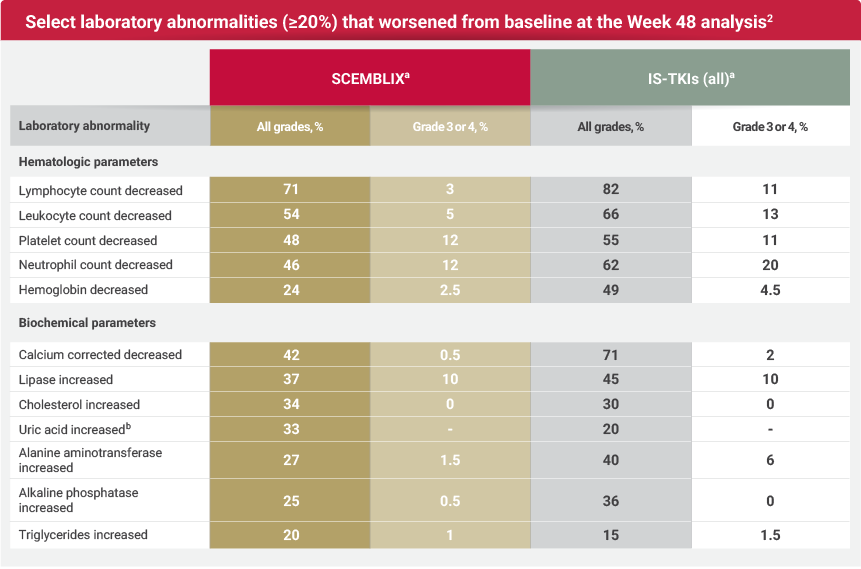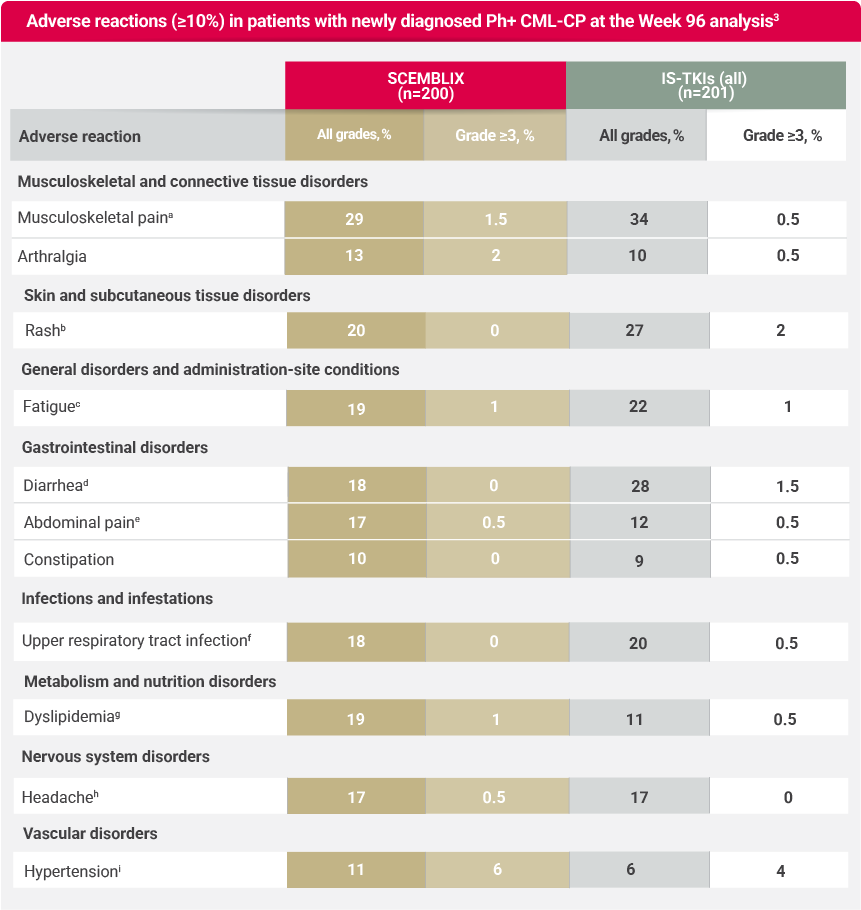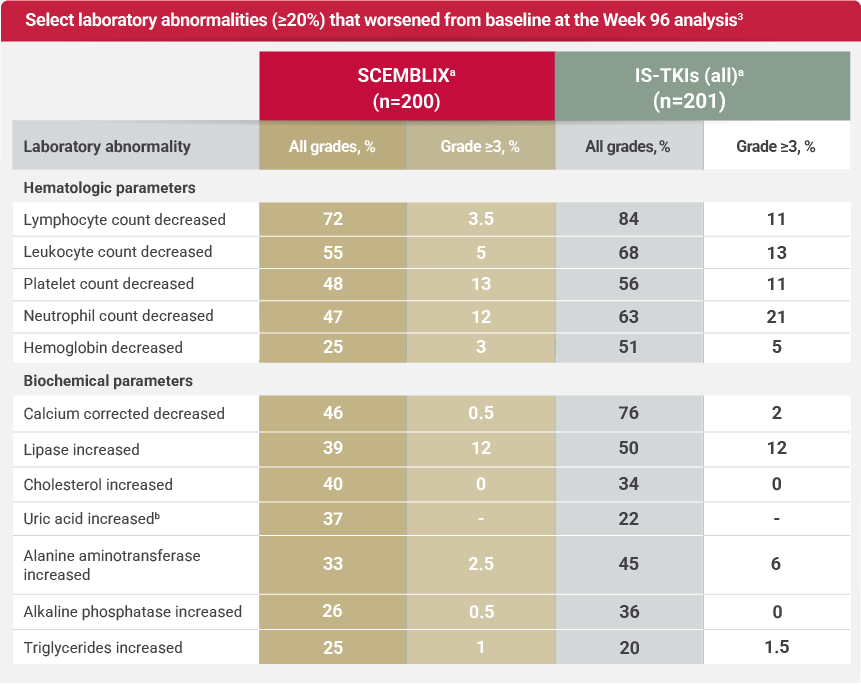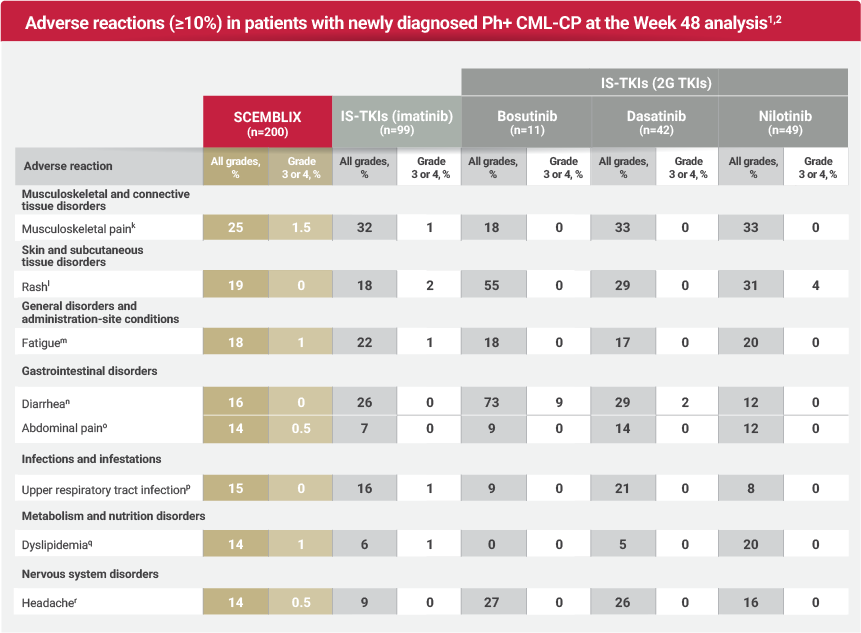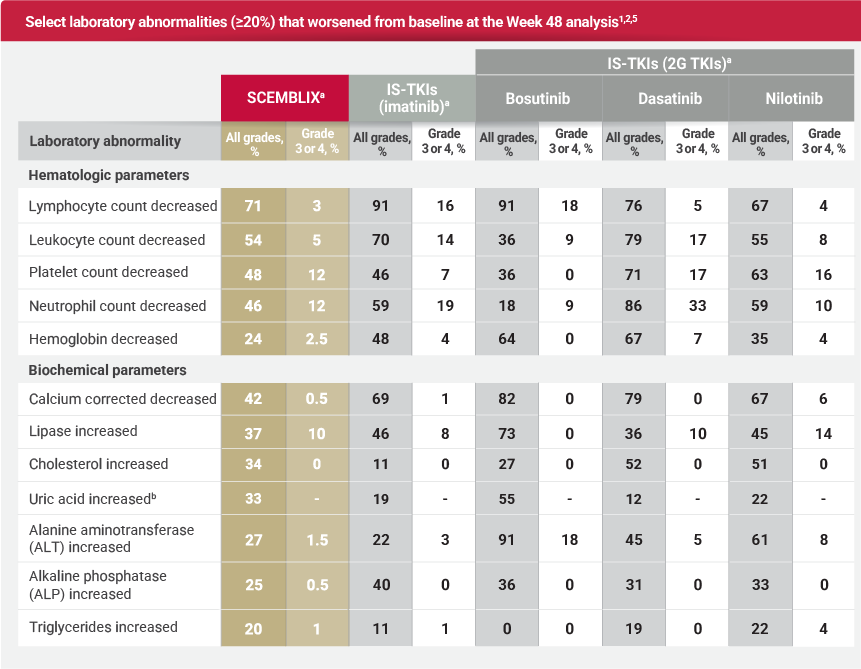
SAFETY PROFILE
For adults with newly diagnosed Ph+ CML-CP
Discontinuation data for SCEMBLIX and standard-of-care* TKIs1,2
*Imatinib, nilotinib, dasatinib, and bosutinib.
At Week 481,2
At Week 963
Dose reductions and interruptions due to ARs (all-grade)
Safety profile at Week 482
aMusculoskeletal pain includes: musculoskeletal pain, myalgia, pain in extremity, back pain, noncardiac chest pain, bone pain, neck pain, musculoskeletal stiffness, musculoskeletal discomfort, musculoskeletal chest pain, arthritis, and spinal pain.2
bRash includes: rash, rash maculo-papular, rash pustular, rash macular, dermatitis exfoliative, drug eruption, dermatitis acneiform, eczema, rash pruritic, and rash vesicular.2
cFatigue includes: fatigue and asthenia.2
dDiarrhea includes: diarrhea, colitis, and enteritis.2
eAbdominal pain includes: abdominal pain, abdominal pain upper, abdominal discomfort, abdominal pain lower, and gastrointestinal pain.2
fUpper respiratory tract infection includes: upper respiratory tract infection, nasopharyngitis, pharyngitis, rhinitis, and respiratory tract infection.2
gDyslipidemia includes: dyslipidemia, hypertriglyceridemia, blood cholesterol increased, hypercholesterolemia, hyperlipidemia, and blood triglycerides increased.2
hHeadache includes: headache and migraine.2
Serious adverse reactions occurred in 11% of patients who received SCEMBLIX. Serious adverse reactions in ≥1% included pancreatitis (1%) and musculoskeletal pain (1%).2
Laboratory abnormalities at Week 482
CTCAE version 5.0.
aThe denominator used to calculate the rate for SCEMBLIX and IS-TKIs (all) varied from 198 to 200 and 201, respectively, based on the number of patients with a baseline value and at least one posttreatment value.2
bWorst postbaseline laboratory abnormalities based on normal ranges.2
Safety profile at Week 963
aMusculoskeletal pain includes: musculoskeletal pain, myalgia, pain in extremity, back pain, non-cardiac chest pain, bone pain, neck pain, musculoskeletal stiffness, musculoskeletal discomfort, musculoskeletal chest pain, arthritis, and spinal pain.3
bRash includes: rash, rash maculo-papular, rash pustular, rash macular, dermatitis exfoliative, drug eruption, dermatitis acneiform, eczema, rash pruritic, and rash vesicular.3
cFatigue includes: fatigue and asthenia.3
dDiarrhea includes: diarrhea, colitis, and enteritis.3
eAbdominal pain includes: abdominal pain, abdominal pain upper, abdominal discomfort, abdominal pain lower, and gastrointestinal pain.3
fUpper respiratory tract infection includes: upper respiratory tract infection, nasopharyngitis, pharyngitis, rhinitis, and respiratory tract infection.3
gDyslipidemia includes: dyslipidemia, hypertriglyceridemia, blood cholesterol increased, hypercholesterolemia, hyperlipidemia, and blood triglycerides increased.3
hHeadache contains: headache and migraine.3
iHypertension contains: blood pressure increased, blood pressure systolic increased, diastolic hypertension, hypertension, and hypertensive crisis.3
Serious adverse reactions occurred in 14.5% of patients who received SCEMBLIX. Serious adverse reactions in ≥1% included pancreatitis (1%), musculoskeletal pain (1%), and peripheral neuropathy (1%).3
Laboratory abnormalities at Week 963
CTCAE version 5.0
aThe denominator used to calculate the rate for SCEMBLIX and IS TKIs varied from 198 to 200 and 201, respectively, based on the number of patients with a baseline value and at least one posttreatment value.3
bWorst postbaseline laboratory abnormalities based on normal ranges.3
EXPANDED SAFETY PROFILE
Safety profile: Expanded by standard-of-care TKIs at Week 481,2
kMusculoskeletal pain includes: musculoskeletal pain, myalgia, pain in extremity, back pain, non-cardiac chest pain, bone pain, neck pain, musculoskeletal stiffness, musculoskeletal discomfort, musculoskeletal chest pain, arthritis, and spinal pain.2
lRash includes: rash, rash maculo-papular, rash pustular, rash macular, dermatitis exfoliative, drug eruption, dermatitis acneiform, eczema, rash pruritic, and rash vesicular.2
mFatigue includes: fatigue and asthenia.2
nDiarrhea includes: diarrhea, colitis, and enteritis.2
oAbdominal pain includes: abdominal pain, abdominal pain upper, abdominal discomfort, abdominal pain lower, and gastrointestinal pain.2
pUpper respiratory tract infection includes: upper respiratory tract infection, nasopharyngitis, pharyngitis, rhinitis, and respiratory tract infection.2
qDyslipidemia includes: dyslipidemia, hypertriglyceridemia, blood cholesterol increased, hypercholesterolemia, hyperlipidemia, and blood triglycerides increased.2
rHeadache includes: headache and migraine.2
Laboratory abnormalities: Expanded by standard-of-care TKIs at Week 481,2,5
CTCAE version 5.0.
aThe denominator used to calculate the rate for SCEMBLIX and IS-TKIs varied from 198 to 200 and 201, respectively, based on the number of patients with a baseline value and at least one post-treatment value.2
bWorst postbaseline laboratory abnormalities based on normal ranges.2
2G, 2nd generation; AR, adverse reaction; CTCAE, Common Terminology Criteria for Adverse Events; Ph+ CML-CP, Philadelphia chromosome–positive chronic myeloid leukemia in chronic phase; TKI, tyrosine kinase inhibitor.

